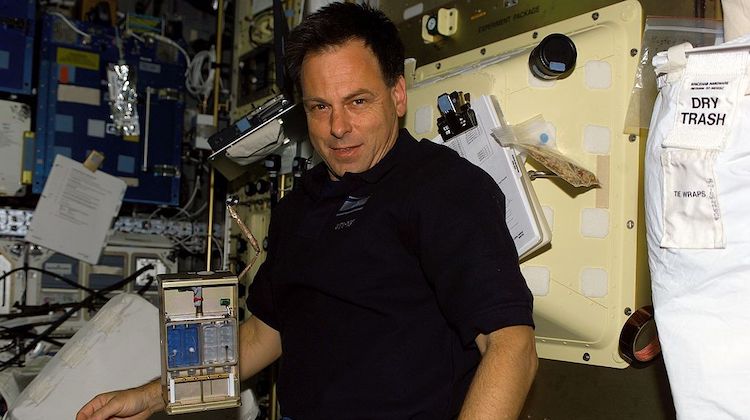Ilan Ramon and the Words That Soared
Reflecting on the legacy of the man who sanctified God from the heavens.

Rabbi Hanina ben Teradyon was executed by the Romans following the fall of the Bar Kokhba revolt in 135c.e. As he was burned alive while holding a Torah in his hands, his students asked their teacher what he saw. He responded, Gevilin nisrafin ve-otiyot porchot: The physical parchment is incinerated, but the letters themselves fly unaffected into the air. This is one of the most resonant tales of Jewish eternity, a sublime and succinct summation of the inability of our enemies to destroy us, and the connection between the Jewish faith—embodied by the Hebrew letters—and the miraculous endurance of our people.
I thought about this story when I watched a scene in the PBS documentary Space Shuttle Columbia: Mission of Hope about the life and death of Israeli pilot and astronaut Ilan Ramon, who perished when the shuttle exploded upon reentry in 2003 and whose 20th yahrzeit, or Hebrew anniversary of death, is now being marked.
More than two decades before Columbia, Ramon had first become bound up with the miraculous tale of the Jewish people. As a young man, he had served in the daring and essential Osirak operation, destroying Iraq’s nuclear reactor. While preparing for his mission, Ramon trained and worked with an Israeli scientist and Holocaust survivor by the name of Yoachim Yosef. He noticed a miniature Torah scroll on the shelf in Yosef’s office. Later, on a live broadcast while in orbit, Ramon held it up and told his country, “This is a tiny Torah scroll that, 60 years ago, a young boy received from a Dutch rabbi, who taught him for his bar mitzvah; and now, it is with me in space.”
Yosef had been the boy. Ramon went on to call Rabbi Simon Dasberg’s Torah a hut hevel mekasher me’od meragesh—a very emotionally resonant tie that binds—and said it represents “the ability of the Jewish people” to endure. For one startling moment, Ramon released the Torah from his hands and it began to float further toward the heavens. In the documentary, Yosef explains that Dasberg had given him the scroll in Bergen-Belsen and instructed him to “tell the story” of what had occurred. Yosef felt he had not yet fulfilled his mission, and that Ramon had made it possible for him to do so. And then, tragically, the Columbia erupted upon reentry.
But the story of Ramon did not end there. This year, Eitan Stibbe, a former comrade-at-arms of Ramon and a successful Israeli entrepreneur, purchased a ride aboard Elon Musk’s SpaceX, thus becoming the second Israeli in space. In describing, on his website, what items he would be taking aboard with him, Stibbe posted images of pages of Ilan Ramon’s diary. These pages somehow survived the destruction of Columbia and were discovered in a field in Texas. The wonder of their continued existence has been described by the Israeli forensics expert Sharon Brown, who first examined them: “Papers that were white with black handwriting on it—they were a bit tattered and traumatized, but nothing like you’d imaging from the huge explosion that took place 40 miles up in the sky and then being hurtled down to earth. It was truly amazing.” The pages burned, but the letters survived.
I had the opportunity to ponder the pages of Ramon’s diary more carefully when Stibbe posted images of the pages on his website. Here before me were arrayed two papers of very different natures, each charred, with some words missing. One clearly describes the wonder of liftoff: “shemonah dakot, ve’od shniyot…anahnu bahalal”—eight minutes and a few more seconds…we are in space! The man who had experienced more aviation than most, and who had participated in one of the most daring air raids in history, could not contain his wonder at the launch.
On the other page were words of a very different sort. Knowing that he would be spending Shabbat in space, Ramon had brought with him the words of the kiddush, the traditional Friday-night blessing over sacred time: “Blessed art Thou…who sanctifies us with His commandments…and You gave us in love this Sabbath day…a remembrance of act of creation…first among sacred days, a remembrance of the Exodus of Egypt.”
Studying both pages, I realized that I was seeing a simple and sublime summation of one of the great works of Jewish thought: Rabbi Joseph Soloveitchik’s The Lonely Man of Faith. Composed during the space race, The Lonely Man of Faith ponders two aspects of human nature that are equally ingrained with us. The first is the urge for invention, which has glorious and life-affirming results: “Man of the seventeenth and eighteenth centuries who needed several days to travel from Boston to New York was less dignified than modern man who attempts to conquer space, boards a plane at the New York airport at midnight and takes several hours later a leisurely walk along the streets of London.” Or, as Ilan Ramon might have put it, eight minutes, a few seconds…and we are in space.
Yet Rabbi Soloveitchik urges modern society to remember that a world solely defined by technology would leave us less connected, not more; only in a faithful covenantal community are we truly linked to those who have come before and those who follow. The man of faith “finds deliverance from his isolation in the ‘now,’” because a covenantal community
cuts across the centuries, indeed millennia, of calendaric time and unites those who already played their part, delivered their message, acquired fame, and withdrew from the covenantal stage quietly and humbly with those who have not yet been given the opportunity to appear on the covenantal stage and who wait for their turn in the anonymity of the “about to be.”
So Rabbi Soloveitchik wrote, and suddenly arrayed virtually before me were exquisite embodiments of his themes: one page about the wonder of orbiting the earth in a few minutes of time, and one page describing the desire of Jews throughout eternity to experience sacred time and unite ourselves with those who come before. Thus it was that, as Eitan Stibbe took off on SpaceX, the pages of Ilan Ramon’s diary accompanied him, orbiting the earth until they safely returned. The paper burned, but the letters soared. The pages of a diary that survived an inferno now took flight once more, as the man who sanctified God’s name in the very heavens lived again.
This essay was originally published in Commentary.
Reflecting on the legacy of the man who sanctified God from the heavens.
Reflecting on the legacy of the man who sanctified God from the heavens.

